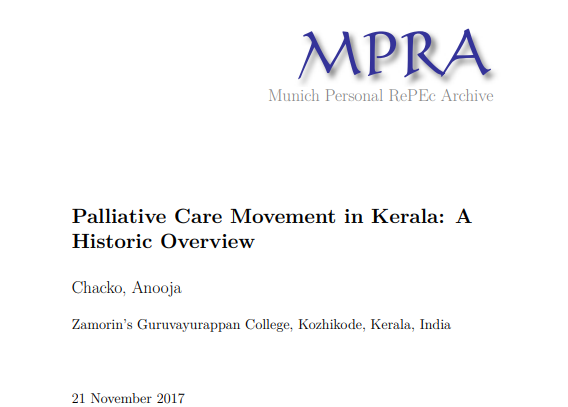Palliative Care Movement in Kerala: A Historic Overview
Kerala, the southern state of India, is celebrated for its achievements in health and education, often cited as a development model by social scientists. However, the state's health system historically prioritized disease prevention and cure, overlooking the emotional and physical relief required by patients beyond the stage of curability. This gap led to the emergence of the palliative care movement, which gained prominence in Kerala, particularly in the Malabar region, setting a precedent for the rest of India. This paper traces the evolution, significance, and impact of the palliative care movement in Kerala’s health system, emphasizing its socio-economic and demographic contexts.
Evolution of the Palliative Care Movement
Kerala’s palliative care journey began in 1993 with the establishment of the first unit at Kozhikode Medical College, in collaboration with the Institute of Palliative Medicine (IPM). This initiative marked a paradigm shift in the state’s health model by integrating supportive care into traditional medical practices. By 1999, community-driven initiatives like the ‘Neighborhood Support in Palliative Care’, spearheaded by four NGOs, laid the foundation for grassroots participation in palliative care.
Recognizing the significance of these efforts, the Government of Kerala introduced the Pain and Palliative Care Policy in 2008, making palliative care an integral part of primary healthcare. This policy empowered local self-governments to implement community-based home care models, supported by the National Rural Health Mission (NRHM) under the ‘Arogya Keralam’ initiative. These measures extended the movement’s reach to over 400 panchayats, integrating palliative care into the broader healthcare infrastructure.
Streams and Innovative Practices
Kerala’s palliative care initiatives are categorized into five primary streams:
Government and Local Self-Government Initiatives: Utilizing Accredited Social Health Activists (ASHAs) and NRHM, these programs deliver care at the grassroots level.
Community-Based Organizations (CBOs): Volunteer-driven neighborhood networks, particularly in North Malabar, pioneered this movement.
Hospital-Linked Services: Institutions like IPM provide specialized inpatient and outpatient care.
Home Care Services: Teams comprising medical professionals and volunteers offer personalized care to bedridden patients.
Patient Outpatient Care: Leveraging hospital facilities, healthcare professionals provide tailored support to chronic patients.
Innovative programs such as ‘Students in Palliative Care’ (SIPC) and vocational training initiatives like ‘Footprints’ exemplify Kerala’s commitment to holistic palliative care. These efforts integrate social responsibility, empowering educational institutions, local governments, and community organizations to participate actively.
Impact and Global Significance
Kerala’s palliative care model has transformed healthcare by addressing not just medical but also emotional, psychological, and social dimensions of chronic illness. It is widely regarded as a scalable and replicable model. The Institute of Palliative Medicine in Kozhikode has emerged as a global leader, collaborating with WHO and other international organizations to promote palliative care worldwide.



Comments
Post a Comment